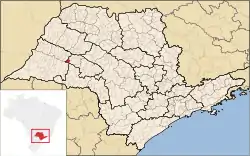Bastos | |
|---|---|
 Flag  Coat of arms | |
 Location in São Paulo state | |
 Bastos Location in Brazil | |
| Coordinates: 21°55′19″S 50°43′55″W / 21.92194°S 50.73194°W | |
| Country | Brazil |
| Region | Southeast |
| State | São Paulo |
| Area | |
| • Total | 172 km2 (66 sq mi) |
| Highest elevation | 445 m (1,460 ft) |
| Population (2020 [1]) | |
| • Total | 20,953 |
| • Density | 120/km2 (320/sq mi) |
| Time zone | UTC−3 (BRT) |
Bastos is a municipality in the state of São Paulo in Brazil. The population is 20,953 (2020 est.) in an area of 172 km2.[2]
History
The name originated from Henrique Bastos, who owned a farm in the area. And it was these same lands that the foundation of the city occurred on June 18, 1928, by Senjiro Hatanaka, sent by the Japanese government to look for land to receive the waves of Japanese immigrants.
After cycles of crops such as coffee, cotton, sericulture, from 1957, the council found its economic vocation: the laying poultry. The city has the largest flock of laying hens in the country and thus is the municipality with the highest production of eggs from Brazil, so the self-titling of "capital of the egg." Bastos is also the headquarters of the Brazilian city of the Egg Festival. This festival brings together not only an exhibition of innovations and products used in the poultry industry, as well as concerts and entertainment for the general population and the region of Bastos.
Geography
Demographics
Census Data - 2000
Total Population : 20,588
- Urban: 17,040
- Rural: 3548
- Male: 10,247
- Female: 10,341
Population density (inhabitants / km ²): 120.82
Infant mortality by 1 year (per thousand): 8.78
Life expectancy (years): 75.55
Fertility rate (children per woman): 2.06
Literacy Rate : 90.20%
Human Development Index (HDI): 0.798
- HDI-M Income: 0.693
- HDI-M Longevity: 0.843
- HDI-M Education: 0.859
(Source: IPEA DATA)
Ethnic groups
Source: 2000 census:
| Color / Race | % |
|---|---|
| White | 57.4% |
| Black | 2.0% |
| Pardo | 28.6% |
| Asian | 11.4% |
| Indigenous | 0.1% |